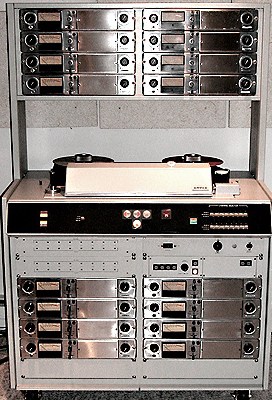Multitrack Tape Recorders: Which ones are OK?
Let’s preface this with the understanding that we are discussing 2” multitrack machines. 16 or 24 tracks, it doesn’t matter. OK …
The question is quite simple: Do you want a tape recorder that actually functions properly and consistently? Or do you want a refrigerator sized hobby that you can tinker with for days on end? Have you ever heard the sound of your 2” tape being folded in half and stretched? (I have …) Or heard nice punch in and out thumps in the middle of your lead vocal tracks on a ballad? ( Oh yes, I have …) Or told the group of musicians who paid for their time and are on a tour “I have to call the tech” because the damned tape deck won’t go into record? … (uh huh) …
This is 2019. Many multitrack recorders have become available that were based on electronic and mechanical designs done in the late ’60s or early ’70s. That’s 50 years ago … I include Ampex MM1000, 1100, and 1200, MCI machines of all types, most Studer, Scully, and numerous other brands.
The mechanical designs of these machines are borderline at best. It’s simple: 2 inch tape is heavy. Moving 2 inch tape precisely and consistently from one end of a reel to the other is not easy to accomplish.
Electronically, they all suffer from noisy and/or slow punch ins/punch outs.
And maintenance: these machines are a bear to keep working, even for a short time. Parts are difficult to find. Techs who actually know the machines are harder to find.
The remote control and autolocator functions of these machines are inadequate, inaccurate, and often nonexistent.
Do not succumb to some “expert” audio dealer’s rap about “this machine sounds great, and has been rebuilt … blah blah blah … the heads look good.”
Free is too expensive:
MACHINES YOU CAN NEVER BUY AT ANY PRICE:
Scully 100, MCI JH5, JH10, or JH16, ACES, Saturn, Ampex 1100, ATR124 (unless you are a bored computer/electronics and mechanical genius), Studer A80 MK1,2 and Otari MTR90 MK1. I’m sure I can add to the list.
These machines require constant attention and alignment. And let’s be clear: if they are not properly mechanically aligned some of these machines can Eat Your Tape! If you are a technodude who needs a hobby, this could be your life … BUT, if you actually want to record music, do sessions with other people and maybe even attract clients to pay for studio time, there are ONLY three machines you can buy…PERIOD!
1st picks: Studer A827 or A820 … They are the best machines ever made, for a plethora of reasons, the most important being that they are very stable and reliable. The functions are awesome, and of course, they sound great! They lock up to anything, and their remote control is very talented. These days they are usually available for under $10,000.
2nd pick: Otari MTR90 MK2 ( or a MK3, but you can’t find one, and NEVER an MTR90 Mark ONE!)
The MK2 is inexpensive to buy, reliable, gentle on tape, does flawless punches; just great remote and locator. Usually found for under $5,000.
These 3 machines can be repaired, work day to day with minimal attention, and look good.
I know … “my favorite recordings were done on a (fill in the blank).” So?
This is 2019. Do you want to record, or wax poetic about your tape recorder having done Elvis? That’s it, that’s my rap; take it or leave it, but Don’t Say I Didn’t Warn You!
On a side note: Tom Sharples, one of the original partners at Hyde Street Studios, was the chief electronics tech for Otari America. When we started the studio, Tom brought in an MTR90 MK1. This was the original Japanese designed machine and it was a borderline P.O.S. Over the course of the first 6 months or so, he got yelled at so much by our engineers, and did so many modifications that he eventually completely redesigned the machine; the MTR90 MK2 was born … and within 3 years became the standard of the industry in tape machines. Tom is not only brilliant, he can actually play the guitar. I think it may have been my idea for him to make it easy to record backwards on the machine … I remember telling him a story about some MCI machine you could reverse some plug on to make it work backwards, “could you do that with a switch?” … he said “that wouldn’t be hard” or something. It’s all a bit hazy …


Thanks Dan! Does this mean I’m famous at last?
You’re famous at my house!